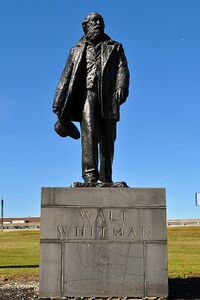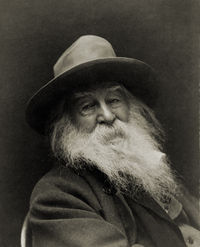Walt Whitman: Difference between revisions
Dario Agazzi (talk | contribs) m (Point at the end of the sentence) |
mNo edit summary |
||
| (One intermediate revision by one other user not shown) | |||
| Line 9: | Line 9: | ||
Whitman was born in West Hills, Long Island, New York. He started as an office boy in a law firm, worked as a printer, then as a village school teacher, founded several magazines, built houses, and meanwhile continued working on his magnum opus, ''Leaves of Grass''. He nursed wounded veterans in the aftermath of the American Civil War and provided vivid, first-hand witness to the sufferings of wounded Civil War veterans. He never married, did not seek wealth or influential connections, and was invariably optimistic and cheerful. Whitman passed away while living in Camden, New Jersey. | Whitman was born in West Hills, Long Island, New York. He started as an office boy in a law firm, worked as a printer, then as a village school teacher, founded several magazines, built houses, and meanwhile continued working on his magnum opus, ''Leaves of Grass''. He nursed wounded veterans in the aftermath of the American Civil War and provided vivid, first-hand witness to the sufferings of wounded Civil War veterans. He never married, did not seek wealth or influential connections, and was invariably optimistic and cheerful. Whitman passed away while living in Camden, New Jersey. | ||
<onlyinclude> | <onlyinclude> | ||
== Whitman as a cultural icon == | == Whitman as a cultural icon == | ||
| Line 84: | Line 83: | ||
</references> | </references> | ||
</onlyinclude> | </onlyinclude> | ||
[[Category:Suggestion Bot Tag]] | |||
Latest revision as of 12:01, 6 November 2024

Walt Whitman (1819 - 1892) was an American poet whose best known work is the poetry collection Leaves of Grass[1][2], a book-sized opus written in a flowing free verse style. It is now considered a masterpiece of American literature, and Whitman is known as the innovator who first introduced the free verse style of writing poetry. Whitman self-published the book in 1855 and continued revising it until his death. Some of its contents were controversial for the Victorian ethics of his time, and it was initially largely overlooked in the United States. Outside the U.S.A., the reception was much better, especially in France, where Whitman's humanism influenced the naturalist literary movement. By 1865, Leaves of Grass had made Whitman famous and was at last accepted by a major publishing house.
Whitman was born in West Hills, Long Island, New York. He started as an office boy in a law firm, worked as a printer, then as a village school teacher, founded several magazines, built houses, and meanwhile continued working on his magnum opus, Leaves of Grass. He nursed wounded veterans in the aftermath of the American Civil War and provided vivid, first-hand witness to the sufferings of wounded Civil War veterans. He never married, did not seek wealth or influential connections, and was invariably optimistic and cheerful. Whitman passed away while living in Camden, New Jersey.
Whitman as a cultural icon

Whitman has recently been resurrected as a popular heroic figure, seen as embodying acceptance for androgyny, bisexuality, and sensuality in general[3], a contemporary trend of evaluating writers more for being perceived as a member of a suppressed social group than on literary merit. Whitman's enduring popularity has scarcely needed the boost of this phenomenon. His importance in American culture, especially in the northeast United States, is reflected in the schools, roads, rest stops, and bridges that have been named after him[4], including the Walt Whitman bridge spanning the Delaware River between Philadelphia and New Jersey that opened for traffic in 1957. The controversy which surrounded its naming has been documented in a series of letters from members of the public held in the University of Pennsylvania library [5]. The web page about this matter states: "The bridge was meant to be named after a person of note who had lived in New Jersey, but some area citizens opposed the name 'Walt Whitman Bridge'...Many objecting to the choice of his name for the bridge saw Whitman's work as sympathizing with communist ideals and criticized him for his egalitarian view of humanity."
Examples of his writing
Reading Whitman's free verse can seem a little like wandering in an overgrown, late summer meadow; there will be much of disordered plants, sticks, straws, brambles, tangles, and dense vegetation--and occasionally, clear areas of astonishing beauty.
An excerpt from 'Song of Myself'[6]
Some people have claimed that the title of the book was a pun by the original printers demeaning the book (where "grass" refers to writings of little value), but given the content, that is highly unlikely.
A child said What is the grass? fetching it to me with full hands;
How could I answer the child? I do not know what it is any more than he.
I guess it must be the flag of my disposition, out of hopeful green
stuff woven.
Or I guess it is the handkerchief of the Lord,
A scented gift and remembrancer designedly dropt,
Bearing the owner’s name someway in the corners, that we may see
and remark, and say Whose?
Or I guess the grass is itself a child, the produced babe of the vegetation.
Or I guess it is a uniform hieroglyphic,
And it means, Sprouting alike in broad zones and narrow zones,
Growing among black folks as among white,
Kanuck, Tuckahoe, Congressman, Cuff, I give them the same, I
receive them the same.
And now it seems to me the beautiful uncut hair of graves.
Poem: A Noiseless Patient Spider
This short Whitman poem in free verse is included in most American poetry anthologies:[7]:
A noiseless patient spider,
I mark’d where on a little promontory it stood isolated,
Mark’d how to explore the vacant vast surrounding,
It launch’d forth filament, filament, filament out of itself,
Ever unreeling them, ever tirelessly speeding them.
And you O my soul where you stand,
Surrounded, detached, in measureless oceans of space,
Ceaselessly musing, venturing, throwing, seeking the spheres to
connect them,
Till the bridge you will need be form’d, till the ductile anchor hold,
Till the gossamer thread you fling catch somewhere, O my soul.
Notes
- ↑ Leaves of Grass' by Walt Whitman, complete text free from Project Gutenberg. As well as shorter poems (notably 'A Noiseless Patient Spider'), Leaves of Grass contains three long poems: ‘I Sing the Body Electric,' ‘The Sleepers,' and ‘Song of Myself'.
- ↑ A group of Whitman poems about the civil war is sometimes published separately under the title Drum-Taps.
- ↑ The New York Times Style Magazine: 'Walt Whitman, Poet of a Contradictory America' by Jesse Green, Sept. 20, 2020, p. 74; last access 9/21/2020.
- ↑ There is the Walt Whitman High School (Bethesda, MD), Walt Whitman Elementary School (Woodbury, NJ), Walt Whitman High School (Huntington Station, NY), Walt Whitman Boulevard (Cherry Hill, NJ), and the Walt Whitman rest stop along the NJ Turnpike in Cherry Hill, to name a few.
- ↑ Delaware River Port Authority records on the naming of the Walt Whitman Bridge, Ms. Coll.1043, last access 9/20/2020.
- ↑ From Leaves of Grass Book III, 'Song of Myself', verse 6 (first half).
- ↑ From Leaves of Grass, 'A Noiseless Patient Spider'.
